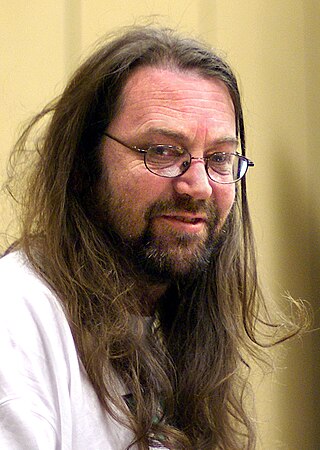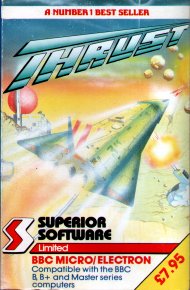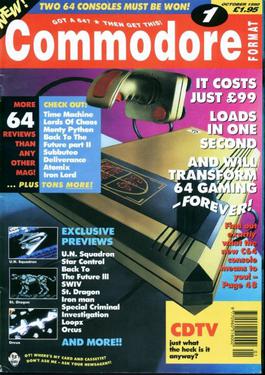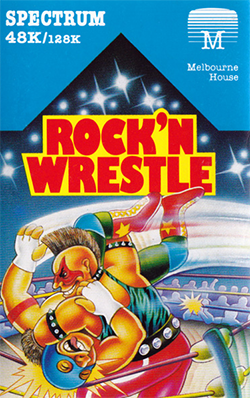
The Commodore 64, also known as the C64, is an 8-bit home computer introduced in January 1982 by Commodore International. It has been listed in the Guinness World Records as the highest-selling single computer model of all time, with independent estimates placing the number sold between 12.5 and 17 million units. Volume production started in early 1982, marketing in August for US$595. Preceded by the VIC-20 and Commodore PET, the C64 took its name from its 64 kilobytes(65,536 bytes) of RAM. With support for multicolor sprites and a custom chip for waveform generation, the C64 could create superior visuals and audio compared to systems without such custom hardware.

Jeff Minter is an English video game designer and programmer who often goes by the name Yak. He is the founder of software house Llamasoft and has created dozens of games during his career, which began in 1981 with games for the ZX80. Minter's games are shoot 'em ups which contain titular or in-game references demonstrating his fondness of ruminants. Many of his programs also feature something of a psychedelic element, as in some of the earliest "light synthesizer" programs including Trip-a-Tron.

Rob Hubbard is a British composer best known for his musical and programming work for microcomputers of the 1980s, such as the Commodore 64.

The C64 Direct-to-TV, called C64DTV for short, is a single-chip implementation of the Commodore 64 computer, contained in a joystick, with 30 built-in games. The design is similar to the Atari Classics 10-in-1 TV Game. The circuitry of the C64DTV was designed by Jeri Ellsworth, a computer chip designer who had previously designed the C-One.
The Commodore 64 amassed a large software library of nearly 10,000 commercial titles, covering most genres from games to business applications, and many others.

Mercenary is a 3D action-adventure game written for the Atari 8-bit computers and published by Novagen Software in 1985. It was converted to the Commodore 64, ZX Spectrum, Amstrad CPC, Atari ST, Amiga, and Commodore 16/116/Plus/4. The game uses vector graphics renderings of vast, sparse environments and has open-ended gameplay. It was also released as Mercenary: Escape from Targ and Mercenary: A Flight Simulator Adventure.

Zzap!64 was a computer games magazine covering games for computers manufactured by Commodore International, especially the Commodore 64 (C64). It was published in the UK by Newsfield Publications Ltd and later by Europress Impact.

Thrust is a 1986 video game programmed by Jeremy C. Smith for the BBC Micro and published by Superior Software. The player's aim is to manoeuvre a spaceship by rotating and thrusting, as it flies over a two-dimensional landscape and through caverns. The gameplay of Thrust was heavily inspired by Atari's Gravitar.

Jeroen Godfried Tel, also known as WAVE, is a Dutch composer. He is best known for numerous computer game tunes he wrote in the 1980s and early 1990s for the Commodore 64. His most popular compositions appear in the following Commodore 64 games: Combat Crazy, Cybernoid, Cybernoid II, Dan Dare 3, Eliminator, Hawkeye, Myth: History in the Making, Nighthunter, Robocop 3, Rubicon, and Supremacy.
Interceptor Micros, also known as Interceptor Software and later as Interceptor Group, was a British developer/publisher of video games for various 8-bit and 16-bit computer systems popular in Western Europe during the eighties and early nineties.

X-Men: Madness in Murderworld is a video game for MS-DOS, Commodore 64, and Amiga systems, which was developed and published by Paragon Software in 1989. The following year, Paragon released a sequel, X-Men II: The Fall of the Mutants.

Commodore Format was a British magazine for users of the Commodore 64 home computer. It was published on the third Thursday of every month. All 61 issues were produced by Future plc. These came towards the end of the machine's commercial life - from October 1990 until October 1995.

Paul Norman is an American game designer, musician, composer, and computer programmer. He has been active in the music scene since 1970 and has been involved with the development of computer entertainment and information since 1982, including the production of Forbidden Forest in 1983.
Troy A. Lyndon is an entrepreneur, game developer, and business coach.

Storm Warrior is a 1989 beat 'em up video game developed and released by Elite Systems for the Amstrad CPC and Commodore 64 8-bit home computer systems. The game casts the player in the role of a prince on a quest to rid his kingdom of a witch's curse. It is unrelated to the 1984 game Storm Warrior.

Barbie is video game for the Commodore 64 published by Epyx in 1984. It allows players to participate in the life of the famous fashion doll of the same name.

Rock'n Wrestle is a professional wrestling video game released in 1985 for the ZX Spectrum, Amstrad and Commodore 64 8-bit home computers, and as Bop'N Wrestle in 1986 for DOS by Mindscape.

Radarsoft is a Dutch software development company that published video games in the 1980s. It released its first game in 1984 for the Commodore 64. Until 1987 Radarsoft released multiple titles for the Amiga, Atari 8-bit computers, Philips MSX, and MS-DOS. Their main focus was the Dutch market, so most games are only available in Dutch. In 1986 Radarsoft went to the American video game market, but a packaging error at a Dutch warehouse cost the studio more money than they were able to recoup.

Scene World Magazine is a disk magazine for the Commodore 64 home computer. The magazine has been released regularly since February 2001.
The Anbernic RG351 is a Linux-based handheld game console created in China by Anbernic. The console uses a microSD card for storage and is a digital ROM-only console. It is the successor to the RG350, and has emerged as a prominent handheld console for retrogaming alongside the Retroid Pocket 2, with the screen aspect ratio of some models particularly optimized for Game Boy Advance titles. It is sold in several models with different shells and screen resolutions, but similar internal specifications. Critics have praised its quality and functionality, but criticized certain aspects of its design.
















